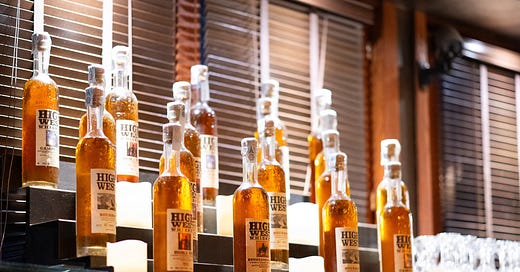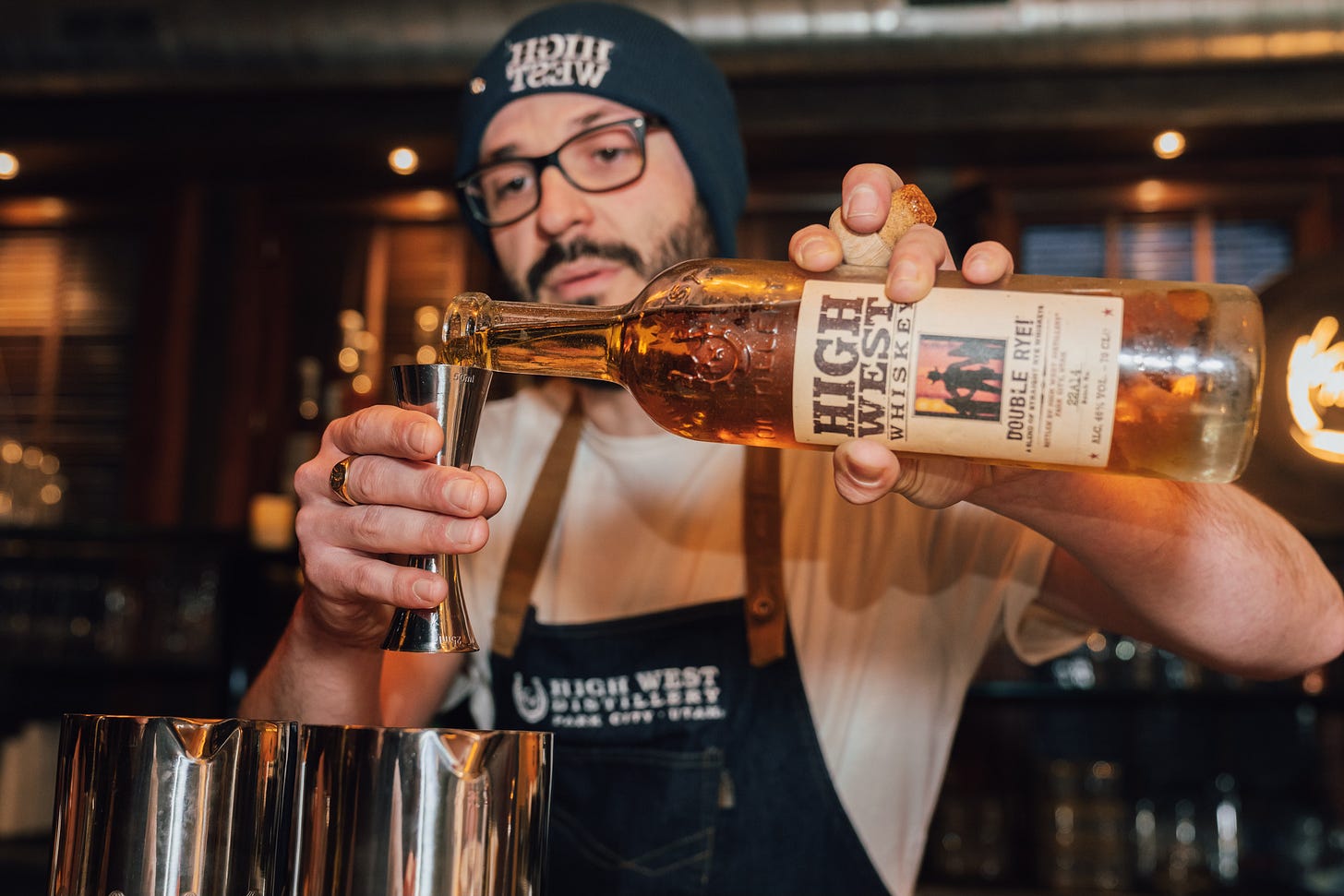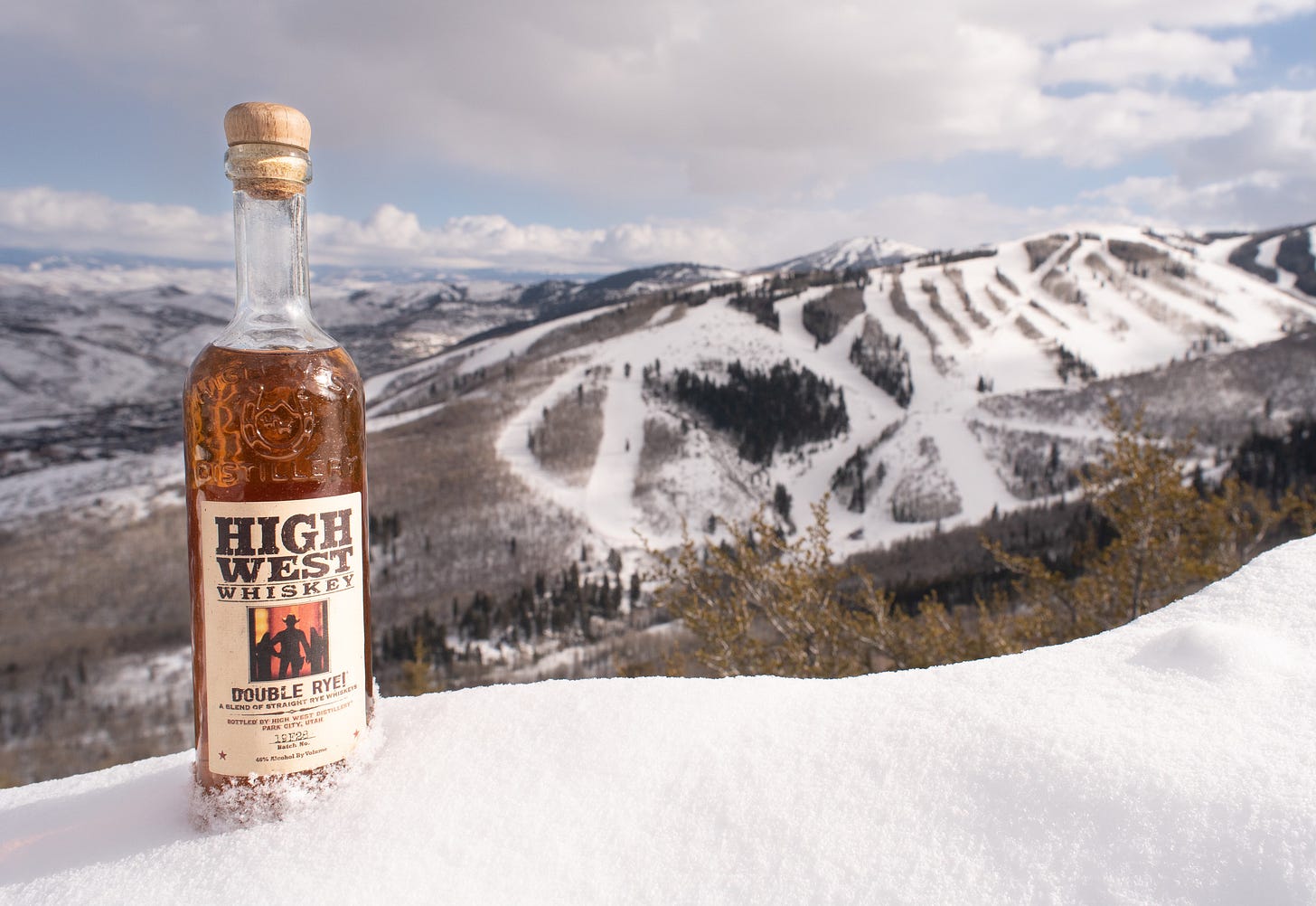There’s a silence in the mountains that feels fuller than anything you’ll find in the city. Not emptier, not lonelier—just fuller. The kind of silence that contains things: possibility, peace, the crunch of snow under your boots, the clink of a glass just before you take a sip. It’s the kind of silence that makes you slow down, look up, and feel like you’re exactly where you’re meant to be. For me, that was drinking a glass of High West whiskey surrounded by the mountains.
I haven’t made it to the mountains of Utah yet where High West is located, but I did go skiing with the team in Chamonix, in the shadow of Mont Blanc. Here, High West had brought together top bartenders from across Europe and a few journalists for the finals of their annual cocktail competition. Think après-ski with cutting-edge cocktails made with one of your favourite whiskies.
It was great to reconnect with Will Baker, who won the UK competition in London, and followed up with the runner-up spot in Chamonix. To see the refinement and ambition brought to a mountain setting - where the cold sharpens everything - was a treat. Skiing with the High West team was a bonus. I used to ski competitively as a schoolboy, but this was my first time back on skis in 15 years. I was a little hesitant, a little rusty, but I loved it.
The winning cocktail, RISKREM by Norway’s Chris Grøtvedt, was a lesson in restraint and comfort. Chris took the judges outside for his slot, away from the warmth of the bar and the comfort of stools. The panel sat cross-legged on the cold ground while Chris, a seasoned competitor, did his thing. It was immersive and memorable. I could visualise the scene back in Norway, this drink shared between friends on a wild camping trip.
The cocktail was a blend of 40ml High West Campfire, 40ml raspberry syrup, 80ml water (or raspberry juice), a pinch of salt and three dashes of Peychaud’s bitters, gently simmered, poured into a ceramic mug, and topped with a float of cream and a sprinkle of sea salt. It was warm, vivid, and deeply satisfying.
Will’s Park City, a tribute to High West’s home, was equally impressive: 50ml High West Double Rye, 15ml Crème de Menthe Blanche, 10ml Cacao Blanc, 5ml Kümmel, and a dash each of Peychaud’s bitters and smoked salt solution (made 8:1 water to salt). Stirred and garnished with grapefruit zest, it was layered and expressive—like an alpine forest wrapped in velvet.
Back in Utah, High West’s roots are unmistakably mountain-born. This isn’t your typical American whiskey distillery. It wasn’t founded in a rolling green valley or beside a bubbling Kentucky spring. No rocking chairs. No sepia-toned family portraits. Just snow-capped peaks and a bold, creative rebellion.
They call themselves “the whiskey from the West.” Not from bluegrass fields or the bourbon trail. Their grandfather’s grandfather didn’t make whiskey—but they do. And that freedom from tradition allows them to make something delicious.
The brand was born in a moment of sensory clarity. During a visit to a Kentucky distillery, David Perkins—a biochemist with a culinary streak—was struck by the smell of caramel and vanilla rising from the barrels. He saw the science in the spirit, the logic in fermentation, and the romance in the result. His wife Jane, whose family had ties to the whiskey world through the Duffy’s Pure Malt brand, was all in. Then came a movie night. High Plains Drifter. Clint Eastwood. Desert winds. A sense of justice and grit. The name High West stuck.
The Perkins family moved to Park City, Utah, and opened a saloon with a 250-gallon still inside a restored livery stable. It was cramped, historic, improbable. But that’s where it began. Today, High West is internationally recognised, yet they’re still pushing boundaries. Still working with rye. Still blending with purpose. Still staring out at snow-covered peaks instead of marketing briefs.
Their saloon is the world’s only ski-in/ski-out distillery. You can literally come off the slope and into a whiskey flight. I’m told the warmth hits you hard but gently: a Campfire Old Fashioned, the scent of woodsmoke and citrus peel, and the low murmur of conversation beside a fire.
They’re serious about whiskey but never self-important. Their core range is deliberately built:
High West Bourbon – balanced, approachable, and classic in form without being predictable.Double Rye – assertive and spicy, evolving into a multi-faceted blend over the years.Rendezvous Rye – their flagship, older and pot-still forward, with richness and layered complexity.Campfire – a daring blend of bourbon, rye, and peated Scotch. It tastes like the West: smoky, bold, and a little untamed.They wouldn’t say where the Scotch comes from, but I have a pretty good idea. If you see me at a bar, I’d be happy to discuss…
High West doesn’t treat blending as a workaround—it’s the foundation. While many American distilleries are purists, sticking to one mash bill and one barrel, High West combines different whiskies, ages, and even sources to create something greater than the sum of its parts. I’ve said this before and I’ll say it again: if you enjoy Champagne, you can’t argue with blending.
During our time in Chamonix, Head Distiller Brendon spoke about the role of malted barley. Legally, bourbon must contain at least 51% corn, but barley has traditionally brought the enzymes necessary for fermentation. While some distilleries have switched to commercial enzymes, High West keeps using malted barley—not for nostalgia, but because it improves the whiskey. It’s about mouthfeel, complexity, and a long, satisfying finish.
Texture is intentional here. High West uses both pot and column stills, pot stills bring weight, column stills bring finesse. Together, they create spirits that feel balanced, layered, and distinctly theirs.
Their limited releases speak volumes. A Midwinter Night’s Dram, a port-finished rye, is one of the most sought-after whiskeys in the U.S. It is released annually, and quickly snapped up. Their Bottled-in-Bond expressions, made under strict government guidelines, give a clear look at what they can do when working within old rules. It’s heritage, reimagined.
High West’s whiskey isn’t just shaped by process—it’s shaped by place. Utah’s dry, high-altitude climate accelerates evaporation during maturation, increasing proof and shifting flavour development. So they adapt: lower barrel-entry proofs, experiments with char levels, and a growing library of casks.
They also take sustainability seriously. All of their electricity is offset via wind power. The stills are cooled using glycol to save water. Spent grain goes to an anaerobic digester to power the Salt Lake City grid. Glass, paper, food waste—it’s all recycled. They’ve pledged $1 million over three years to environmental groups, including Protect Our Winters and the Wildland Firefighter Foundation.
Most of their grain comes from within a day’s drive, reducing freight miles. These are small steps but meaningful ones. This is whiskey with a sense of responsibility.
Of course, none of it matters if the whiskey doesn’t taste good. But it does. In fact it is excellent.
After a day on the slopes in Chamonix, we’d gather, tired, a little achy, quietly euphoric, and sip whiskey while trading stories about the day’s skiing. That’s what High West understands. Not just the science. Not just the branding. But the feeling. They know that the best spirits aren’t just consumed. They’re experienced slowly, in good company, in a place that reminds you what matters.







Such a great article! Thanks for sharing